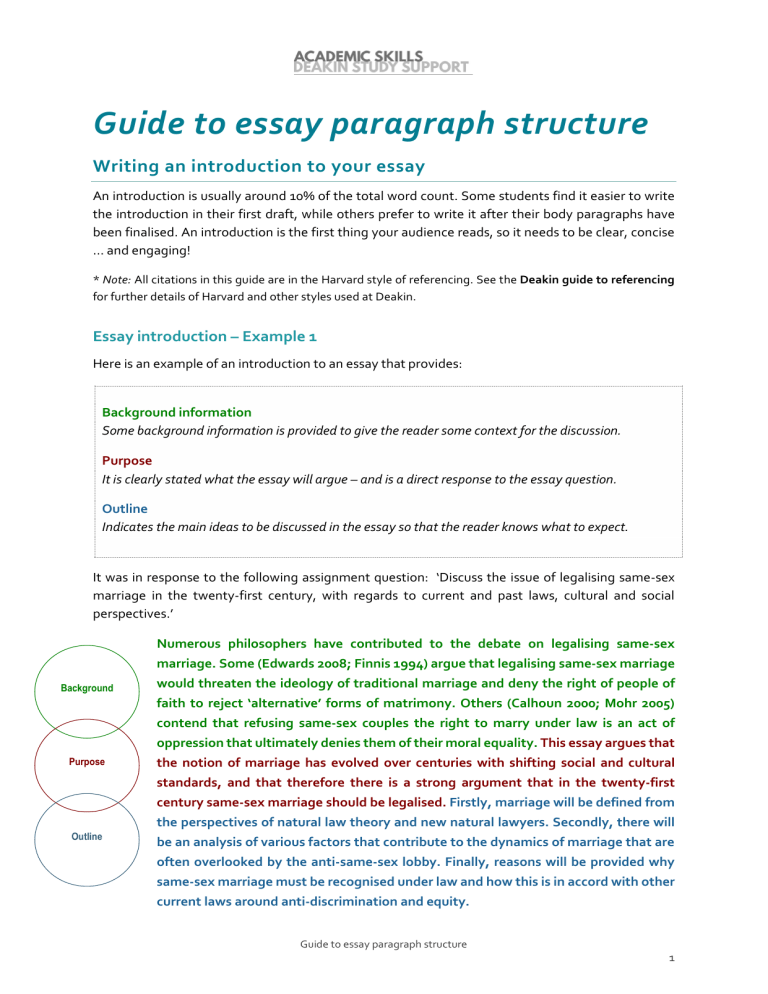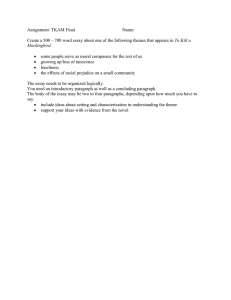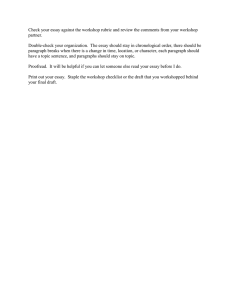
Guide to essay paragraph structure Writing an introduction to your essay An introduction is usually around 10% of the total word count. Some students find it easier to write the introduction in their first draft, while others prefer to write it after their body paragraphs have been finalised. An introduction is the first thing your audience reads, so it needs to be clear, concise … and engaging! * Note: All citations in this guide are in the Harvard style of referencing. See the Deakin guide to referencing for further details of Harvard and other styles used at Deakin. Essay introduction – Example 1 Here is an example of an introduction to an essay that provides: Background information Some background information is provided to give the reader some context for the discussion. Purpose It is clearly stated what the essay will argue – and is a direct response to the essay question. Outline Indicates the main ideas to be discussed in the essay so that the reader knows what to expect. It was in response to the following assignment question: ‘Discuss the issue of legalising same-sex marriage in the twenty-first century, with regards to current and past laws, cultural and social perspectives.’ Numerous philosophers have contributed to the debate on legalising same-sex marriage. Some (Edwards 2008; Finnis 1994) argue that legalising same-sex marriage Background would threaten the ideology of traditional marriage and deny the right of people of faith to reject ‘alternative’ forms of matrimony. Others (Calhoun 2000; Mohr 2005) contend that refusing same-sex couples the right to marry under law is an act of oppression that ultimately denies them of their moral equality. This essay argues that Purpose the notion of marriage has evolved over centuries with shifting social and cultural standards, and that therefore there is a strong argument that in the twenty-first century same-sex marriage should be legalised. Firstly, marriage will be defined from Outline the perspectives of natural law theory and new natural lawyers. Secondly, there will be an analysis of various factors that contribute to the dynamics of marriage that are often overlooked by the anti-same-sex lobby. Finally, reasons will be provided why same-sex marriage must be recognised under law and how this is in accord with other current laws around anti-discrimination and equity. Guide to essay paragraph structure 1 Essay introduction – Example 2 Here is an example of a first-year student’s introduction to a much shorter 500-word essay. Note that there is often no space to provide background information in such a short essay, but the following introduction does include: Purpose This section directly addresses the assignment question. The first sentence identifies the subject of the essay and the second sentence introduces a discussion. Outline Although there is little space to provide an outline, this introduction still provides the reader with some details of what will follow. It was in response to the following assignment question: ‘Identify two significant contributions to early theories of evolution. Discuss the similarities and differences in their key ideas in relation to a particular species.’ Two major schools of thought that significantly contributed to the theory of evolution derive from the renowned naturalists, Jean-Baptiste Lamarck and Charles Darwin. Purpose Although their arguments share a mutual foundation, their ideas differ in regard to how certain characteristics came to appear in certain species, in particular on the question of whether organisms have an ‘internal vital force’ driven by need (Embogama 2014). The differences between these two theories can be clearly Outline demonstrated by a brief consideration of their respective observations and analyses of the anteater. Writing the body paragraphs of your essay The body of your essay is where you detail your ideas. It usually makes up approximately 80% of your essay. It is important to remember that the evidence you provide supports your writing, rather than the other way around! • • • Structure your body paragraphs by beginning with a topic sentence – this is the topic of your paragraph. Provide supporting evidence with citations, but also ensure that you paraphrase and summarise your sources more often than you quote. It is essential that each paragraph have some of your own analysis and commentary. This might include: comparing and contrasting the ideas of others, asking questions, providing further examples or making some conclusions based on your analysis. Guide to essay paragraph structure 2 • • Consider how you will conclude your paragraphs and how your paragraphs link to each other. Remember to be formal, objective and cautious in your writing. Essay body paragraph – Example 1 The following essay body paragraph includes: Topic sentence This is the topic of the paragraph. Note how it begins with the linking phrase ‘Despite the …’, referring to the previous paragraph. Supporting evidence and examples with citations Cite reputable sources only. Summaries, paraphrases and quotes of all sources need to be cited. Analysis It is important to provide some analysis – comparing/contrasting sources, asking questions, making conclusions, etc. Concluding sentence Sometimes paragraphs include a concluding sentence, or a final sentence that links to the following paragraph. Note that drawing your own conclusion is another example of analysis. Despite the focus on hard skills, it appears that the biggest benefit of going to Topic university is not necessarily what you learn, but the people you meet there and the networks that you create. Although graduates often list discipline-orientated goals when asked what their main reason is for enrolling at university, ultimately many Evidence graduates go on to careers and professions unrelated to their degree program (Hopkins & Bylander 2013; Raskovich 2003; Smith 1999). So what kind of transferrable skills do students carry over from their study into their career? Raskovich (2003, p. 217) Analysis suggests that the key relationships and networks created by students at university provide useful professional contacts for the future. This also assists in the development of the interpersonal communication skills sought by employers. Conclusion Student proficiency in a range of digital skills that facilitate online academic, professional and social networks are also important elements in the bigger picture of graduate communication skills. Guide to essay paragraph structure 3 Essay body paragraphs – Example 2 Topic sentence This is the topic of each paragraph. Note how the topic sentence in the second paragraph below begins with the linking word ‘Furthermore’. Supporting evidence and examples with citations Cite reputable sources only. Summaries, paraphrases and quotes all need to be cited. Analysis It is important to provide some analysis – comparing/contrasting sources, re-interpretation of ideas, and making conclusions, etc. Concluding sentence A concluding paragraph is not necessary for every paragraph. Social interaction is one of the fundamental principles of social constructivist theory. Topic In this philosophy, learning is regarded as a social process where people are engaged with social practices (McMahon 1997). Vygotsky (1978) argues that with the help of peer and other mentors, learners develop concepts and ideas that they can go on to Evidence understand independently. In addition, students’ social interactions with other students, academics, and other individuals outside the university, are major influences on individual development and knowledge construction. In other words, Analysis learners interact with members of their community outside the curriculum in order to obtain or understand new knowledge and how to apply it. Topic Furthermore, language becomes a critical tool (Vygotsky 1978) that helps learners to mediate social interactions. It is through speech, primarily, that learners engage with bodies of knowledge that exist in a culture (Vygotsky 1978). As a result, through such Evidence experiences and in challenging and supported environments, learners gradually become skilled at participating in analytical discussions and other activities (Wertsch Analysis 1991, p. 235). Therefore, learners need to engage in social interaction to become aware of others’ ideas, to interpret information derived from the interaction or experience, and thus build and incorporate new knowledge. So the role of language is Conclusion key because it serves as a tool to mediate that engagement. Guide to essay paragraph structure 4 Writing a conclusion to your essay You do not need to add new information, arguments or citations in a conclusion. You may provide: Restatement of topic and summary of response Restate the essay topic and give a brief summary of how you have successfully addressed it – and provide some of the key points. Link back to broader context This is optional, depending on the length and topic of your essay. Suggest directions for further research This is also optional and is usually for longer research essays. Essay conclusion – Example Restatement Broader context Charles Darwin and Jean-Baptiste Lamarck both made significant contributions to theories of evolution. Through a brief analysis of the anteater, this essay has shown that while both naturalists shared a common basis surrounding the question of adaptation, Darwin’s notion of natural selection suggested the initial presence of numerous variations from the beginning; whilst Lamarck’s theory focused on physical and behavioural traits being repeatedly exercised and the resulting qualities being inherited by their offspring. Recent research into epigenetics, which cannot be explained exclusively by Darwinian theory and draws heavily on Lamarck, demonstrates the continued relevance of revisiting the work of these seminal naturalists. Guide to essay paragraph structure 5






